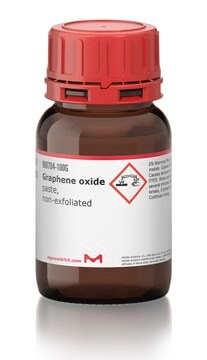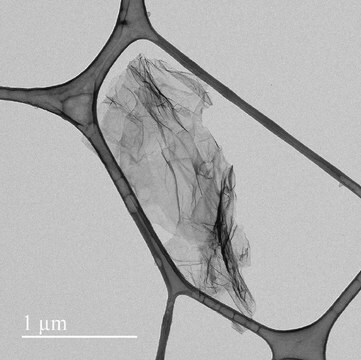777684
Reduced graphene oxide
Sinónimos:
rGO
About This Item
Productos recomendados
description
chemically reduced
Quality Level
form
powder
composition
Carbon, ≥75 wt. %
Nitrogen, >5 wt. %
Oxygen, <22 wt. %
surface area
450 m2/g
conductivity
>600 S/m
solubility
water: insoluble
¿Está buscando productos similares? Visita Guía de comparación de productos
Categorías relacionadas
General description
Application
- chemical sensors, biosensors
- as transparent electrodes in light emitting diodes (LEDs) and ITOs
- in lithium ion batteries.
Preparation Note
- Reduction method: Chemically reduced
- Color: Black
- Odor: Odorless
- Solubility: Insoluble
- Dispersability: It can be dispersed at low concentrations (<0.1mg/mL) in NPM, DMSO, DMF
- Electrical conductivity: > 600S/m
- BET surface area: 450 m2/g
Storage Class
11 - Combustible Solids
wgk_germany
WGK 3
flash_point_f
Not applicable
flash_point_c
Not applicable
Elija entre una de las versiones más recientes:
¿Ya tiene este producto?
Encuentre la documentación para los productos que ha comprado recientemente en la Biblioteca de documentos.
Artículos
Graphene oxide is a unique material that can be viewed as a single monomolecular layer of graphite with various oxygen containing functionalities such as epoxide, carbonyl, carboxyl and hydroxyl groups.
Developed in the last several years, fluorescence quenching microscopy (FQM) has enabled rapid, inexpensive, and high-fidelity visualization of two-dimensional (2D) materials such as graphene-based sheets and MoS2.
Since its discovery little more than a decade ago,1 the two-dimensional (2D) allotrope of carbon—graphene—has been the subject of intense multidisciplinary research efforts.
Advanced technologies for energy conversion and storage are widely sought after for their potential to improve consumer and electronic device performance as well as for the prospect of reducing the societal and environmental impact of energy generation.
Nuestro equipo de científicos tiene experiencia en todas las áreas de investigación: Ciencias de la vida, Ciencia de los materiales, Síntesis química, Cromatografía, Analítica y muchas otras.
Póngase en contacto con el Servicio técnico





